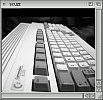ScuzzBlog: Diaries September 2017
Entry 27th September 2017: Post: 1
AMSTRAD Disc Drive & Interface DDI-1 Manual
Foundations 4:
Introducing AMSDOS and CP/M
When you switch your system on, the computer automatically runs internal checks to
see which peripherals are connected to the rear sockets. If the computer senses that a
disc drive(s) is connected, it will take any commands that would have been sent to the
cassette datacorder, and direct them to the disc drive. Hence, typing in any of the
commands:
load filename"
run "filename"
save "fitename"
chain "filename"
merge "filename"
chain merge "filename"
openin "filename"
openout "filename"
closein
closeout
cat
eof
input #9
line input #9
write #9
list #9
will act upon the disc instead of the cassette.
The speed write command however, always pertains to cassette operation, as
there is no such facility as 'disc speed write'.
Having sensed therefore, that a disc drive is connected, the computer reverts to
operation under the AMSDOS system. AMSDOS is an abbreviation of AMStrad Disc
Operating System, and enables you to program in normal Amstrad BASIC, with the
addition of extra commands for disc management.
These commands are called external commands, and are not available in the standard
computer without the disc drive connected. The software governing these commands is
contained in ROM (Read Only Memory) within the Disc Drive and Interface Unit.
External commands are preceeded with a bar symbol |. (You will find the | symbol by
holding down [SHIFT] and pressing the @ key.)
Some of the more common external commands that you will use are:
|a
|b
|tape (which can be sub-divided into |tape.in and |tape.out)
|disc (which can be sub-divided into |disc.in and |disc.out)
The commands |a and |b tell the computer which drive to direct any subsequent
disc command.
Typing in for example:
|a
load "filename"
will tell the computer to load the specified program from a disc placed in drive A.
If neither |a nor |b is initially entered or the computer is reset, the system will
default to drive A.
If you are using only one disc drive, this can be regarded as drive A, and |a or |b
commands need not be issued. Entering |b when only one disc drive is connected, will
result in the message on the screen:
Drive B: disc missing
Retry, Ignore or Cancel
to which you should respond C (to cancel).
The command |tape tells the computer to perform all loading and saving etc.
commands onto tape instead of disc. Unless |tape is entered, the computer will
always default to disc operation when switched on or reset.
To return to disc operation after |tape has been specified, type in:
|disc
Alternatively, you may for example wish to load in from cassette and save out to disc.
You may then use the command:
|tape.in
this command tells the computer to read data in from cassette, but continue to write
data out onto disc (default).
Similarly, to read data in from disc and save out onto cassette, you will first need to
type in: |disc.in to countermand the previously issued |tape.in (above), then: |
tape.out to tell the computer to write data out onto cassette.
It can be seen therefore that |tape.in and |tape.out countermand |disc.in
and |disc.out respectively, and vice versa.
Further information on directing data to and from discs and cassette will be found later
in this manual under the sections concerning AMSDOS and CP/M
AMSTRAD Disc Drive & Interface DDI-1 Manual
|


![]()


![]()